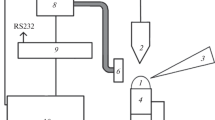Abstract
The simultaneous injection of volatile hydride species and hydrogen gas, originating in reagent decomposition, was monitored during the operation of a continuous hydride generation manifold employed for the determination of trace arsenic by HG-ICP-AES. Line and background intensities as well as the FWHM of the hydrogen Hγ and Hδ lines were measured, and electron number densities (ne) estimated from Stark broadening of the line profiles. Results were compared with those obtained by conventional pneumatic injection of aqueous solutions. Overlapping with atomic nitrogen lines at 410 nm and 411 nm tends to distort the Hδ line profile for the hydrogen-seeded plasma, rendering unreliable results. The N I lines seem to be quenched by the presence of water aerosol. More consistent results were obtained with the Hγ line. When no solutions are pumped through the hydride generation manifold (“dry” plasma), the measured ne value was (1.57 ± 0.22) × 1015cm–3. Conversely, when the reducing reagent flow was replaced by pure water (corresponding to the injection of water vapor in equilibrium that is swept by the argon carrier gas passing through the phase separator), the electron concentration is 25% higher. In that case the ne value agrees between the experimental error with that obtained for a plasma in which a water aerosol is introduced at a flow rate of 1 mL/min. An enhancement of 52% relative is observed in ne when the system is operated under optimized conditions for arsine generation, employing sodium tetrahydroborate in acidic medium as reducing agent (i.e. hydrogen seeded plasma). It was also observed that the continuum emission near 410 nm for the hydrogen containing plasma correlates with the measured electron number density, suggesting that the background enhancement under hydride generation conditions may respond to the ion-electron recombination mechanism.
Similar content being viewed by others

Author information
Authors and Affiliations
Additional information
Received: 3 May 1999 / Revised: 3 August 1999 / Accepted: 6 August 1999
Rights and permissions
About this article
Cite this article
Batistoni, D., Garavaglia, R. & Rodríguez, R. Evaluation of hydrogen line emission and argon plasma electron concentrations resulting from the gaseous sample injection involved in hydride generation-ICP-atomic emission spectrometric analysis. Fresenius J Anal Chem 366, 221–227 (2000). https://doi.org/10.1007/s002160050044
Published:
Issue Date:
DOI: https://doi.org/10.1007/s002160050044



